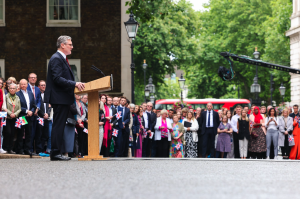After 14 years of Conservative rule, Labour has taken the reins under Keir Starmer with a massive majority as the electoral map shifted from blue to decisive red on 4 July.
massive majority as the electoral map shifted from blue to decisive red on 4 July.
The last time the Labour Party replaced a Conservative government, within a few days it sprung
an economic surprise that nobody saw coming – granting independence to the Bank of England. Just over 27 years later, no such shock move seems likely, but with Labour’s key message a promise of change, what lies ahead?
The challenges
The economic backdrop which Labour inherited on 5 July is markedly darker than that of 27 years ago. In the 1997/98 financial year, government borrowing was 1.1% of GDP and total government debt (ex-Bank of England) was 36.7% of GDP. The corresponding figures for 2024/25 are projected to be nearly triple – 3.1% and 91.7%.
Whereas at the turn of the century the government benefitted from a ‘peace dividend’, the ratcheting up of global tensions of the last few years mean it now faces the opposite situation, with the defence budget set to rise to 2.5% of GDP. Added to that, the much higher debt figure imposes a heavy ongoing servicing cost on the government. Net interest alone is projected to account for nearly £65 billion of expenditure in 2024/25.
The wider range of challenges facing the new Prime Minister and his cabinet go deeper, as identified by chief of staff Sue Gray earlier in the year. These are the specific issues that feel closer to people’s lives than the more abstract public sector borrowing figures which they affect. Chief amongst these are:
- the NHS funding gap and social care requirements;
- public sector pay negotiations, particularly around the NHS;
- local council bankruptcies;
- the housing deficit;
- potential collapse of the largest water company, Thames Water;
- overcrowding in prisons and the criminal justice backlog;
- the schools and university funding crisis.
In these financial circumstances, a government elected under the banner of change will soon face tough decisions on tax, spending and borrowing. The honeymoon – arguably more relief than joy at the change of government – may not last long.
Tax focus
Tax was a key attack area for the Conservatives during the election, who were themselves on weak ground due to their recent record. Labour’s manifesto listed its now familiar (and distinctly modest) tax raising plans of:
- reducing tax avoidance;
- revising non-domiciled taxation rules;
- levying VAT and business rates on private schools;
- ending the capital gains tax treatment of carried interest;
- a windfall tax on ‘oil and gas giants’; and
- increasing stamp duty land tax rates by one percentage point on residential property purchases by non-UK residents.
The manifesto also said “We will ensure taxes on working people are kept as low as possible. Labour will not increase taxes on working people, which is why we will not increase National Insurance, the basic, higher, or additional rates of Income Tax, or VAT.” Unfortunately, the definition of ‘working people’ was never resolved during the election campaign. In interviews, Keir Starmer and Rachel Reeves did not appear to agree.
The manifesto additionally promised to cap corporation tax at 25% but was silent on inheritance tax (IHT) and capital gains tax (CGT), both arguably not taxes of ‘working people’. This pair of capital taxes could feature in the next Budget, although HMRC’s own estimates suggest a sharp rise in CGT rates would be self-defeating because of ‘behavioural effects’, e.g. gains would just be left unrealised. On the other hand, a month before the election was called, the Institute for Fiscal Studies published a paper explaining how the closure of three IHT ‘loopholes’ could raise nearly £4 billion a year by 2029/30.
An autumn Budget
Rachel Reeves, the first female Chancellor, ruled out an emergency Budget and has said she will give the Office for Budget Responsibility (OBR) the normal ten weeks’ notice to prepare an Economic and Fiscal Outlook ahead of her first Budget. However, over the weekend she requested an update from the Treasury on the UK’s financial position which will be presented to parliament by the end of this month. In announcing the review on Monday, Reeves added “difficult decisions” lay ahead.
In theory the earliest Budget date could be Friday 13 September, or 18 September if she sticks with the traditional Wednesday for Budget Day. Such a tight timeline is now thought to be unlikely for three reasons:
- The Labour Party’s Conference starts in Liverpool on 22 September.
- Reeves will want to make decisions on the next Spending Review, both in terms of its contents and whether it will cover the next three years from April 2025 (as originally scheduled) or be an interim review for just the coming year.
- One of the surprise Labour losses in the election was Jonathan Ashworth, the former Shadow Paymaster General and a key member of Reeves’ shadow Treasury team.
The Parliamentary timetable
An early summer election has meant that the timing of when the new parliament can get down to work is contingent upon some basic realities of the Parliamentary and party calendars:
- State Opening on 17 July After the process of electing the speaker and swearing in MPs, due to begin from 9 July, 17 July marks the State Opening of Parliament and the King’s Speech. The Speech will show the government’s immediate priorities and be followed by six days of debate in the Commons.
- Summer recess Before parliament was dissolved, the House of Commons had been scheduled to start the summer recess on 23 July. The new government is set to push that date out, although there is a tension between being seen to take early action and giving MPs and their teams and families sufficient time to recover from the election campaign. Whenever the Commons does rise, it will probably return, as usual, in the first week of September.
- Conference recess In the past, the House of Commons has taken a three or four weeks recess in September/October to allow MPs to attend their party conferences. In 2024 the LibDem Party’s conference runs from 14-17 September, Labour’s from 22-25 September and the Conservatives’ from 29 September to 2 October. The new government will probably not want the House of Commons to be absent for so long.
The hundred days
In his speech on the steps of Downing Street on 5 July, Keir Starmer said “the work of change begins immediately.” As the tricky summer timeline shows, there isn’t much parliamentary time for the government to work with before they hit 12 October, which will mark the end of Labour’s first 100 days in office. In political folklore this is the period when a new government has the greatest political capital. Given the challenges and expectations of the new government, working up to that point will focus the mind of the Prime Minister and his advisers when reviewing those recess periods and setting a date for their first Budget.
The Chancellor is due to meet with the OBR over the next few days. Focusing on housing, removing planning restrictions and the ever-present need for growth in her first speech to the Treasury on 8 July, Reeves that she would confirm a Budget date before the summer recess for “later in the year”. Those 100 days are going to be very busy.
Whilst there was a lot of concern before the election that there could be some retrospective tax measures introduced, the initial signs are that the new government is taking a measured and pragmatic approach.
The information in this article was correct at the date it was first published.
However it is of a generic nature and cannot constitute advice. Specific advice should be sought before any action taken.
If you would like to discuss how this applies to you, we would be delighted to talk to you. Please make contact with the author on the details shown below.








